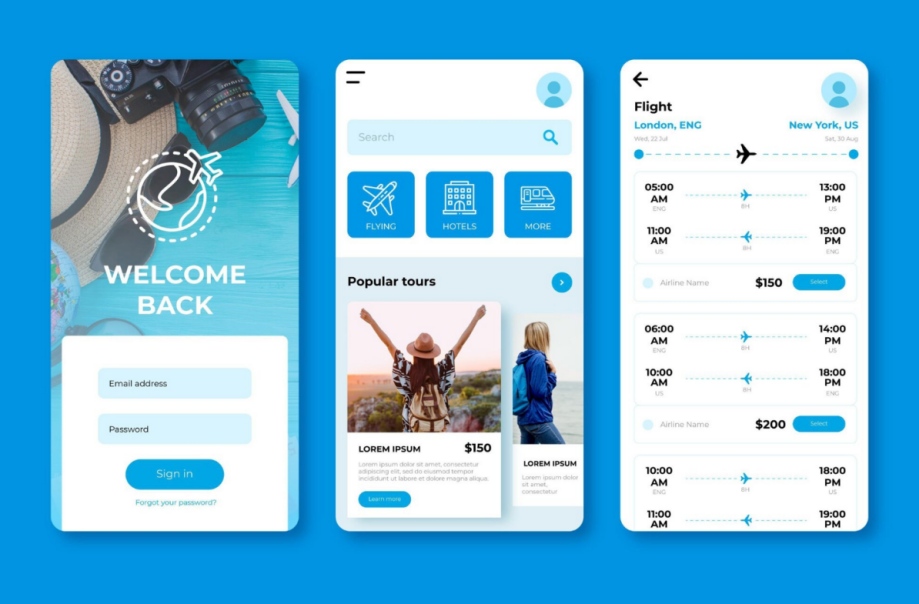How to Build a Successful Travel App: A Step-by-Step Guide
— November 25, 2024Introduction
The travel industry has evolved dramatically, shifting from paper-based bookings to a mobile-first experience where users demand convenience, speed, and personalization. Over 80% of global travelers book trips online, with Millennials and Gen Z accounting for most of these bookings. This shift presents a lucrative opportunity for businesses to attract and retain travelers by offering intuitive, feature-rich travel apps.
Advanced technologies like Artificial Intelligence, Machine Learning, and Predictive Analytics empower developers to build apps that cater to user preferences while delivering seamless, engaging experiences. This guide outlines the critical aspects of travel app development, including app types, features, costs, and revenue models, to help you create a standout solution in the competitive travel sector.
Choosing the Right Travel App Type
Before developing a travel app, you must define its purpose and audience. Successful travel apps address specific pain points and provide unique value. Below are the main categories of travel apps to consider.
Travel Booking Apps
Travel booking apps simplify the process of securing flights, rental cars, and hotels in one place. Apps like Expedia and Booking.com are examples of this category. These apps save users time by integrating multiple services into a single platform. If you aim to build a travel booking app, identify gaps in your target market, such as specialized booking options or better pricing features, and focus on filling them.
Travel Itinerary Apps
Planning a trip often involves juggling multiple reservations and activities. This kind of app will solve this problem by organizing all travel details in one accessible location. By helping users streamline their plans, itinerary apps enhance their travel experience. If you aim to develop this type of app, prioritize organization, and user-friendly navigation.
Navigation Apps
Navigation apps guide travelers through unfamiliar cities. Google Maps sets the standard with features like real-time traffic updates, offline maps, and location sharing. A navigation app with added functionalities, such as AR-based directions or integration with local attractions, could capture a loyal audience.
Local Experience Apps
Modern travelers increasingly seek authentic, local experiences. Apps like Airbnb Experiences connect users with unique activities and local guides. Building an app that promotes hidden gems and cultural insights can appeal to adventurous travelers. Adding interactive features like virtual tours or curated content could further enhance its appeal.
Travel Expense Management Apps
Managing finances while traveling is a common concern. Apps like Splitwise allow users to track spending and split expenses with companions. A travel expense app with real-time currency conversion and integrated payment options could simplify budgeting for users, making it an invaluable tool for travelers.
Overcoming Challenges in Travel App Development
Developing a travel app involves addressing specific challenges to ensure success. Below are key hurdles and strategies to overcome them.
Regulatory Compliance
Travel regulations vary globally and influence data handling, payments, and service offerings. Ignoring these requirements can result in penalties or loss of customer trust. To mitigate this, integrate a compliance framework into your app and consult legal experts regularly to stay updated on evolving laws.
Scalability During Peak Traffic
Travel apps often experience traffic surges during holidays and peak seasons. An unprepared app may crash, leading to lost revenue and reputational damage. To address this, build a scalable backend that adjusts to increased traffic automatically.
Localization and Multi-Language Support
Catering to a global audience requires localization. Your app should support multiple languages and adapt to cultural preferences, such as date formats and payment methods. Investing in professional translation and regional design variations will improve user satisfaction and drive engagement.
Benefits of a Travel App
Travel apps simplify trip planning and enhance the overall experience for users. They offer convenience by consolidating information about flights, accommodations, and activities in one place. Users save time and effort by avoiding manual searches across multiple platforms. Travel apps also provide personalized recommendations based on user preferences, making trip planning more enjoyable and tailored to individual needs. Real-time updates about flight schedules, weather, and travel advisories improve travel efficiency and reduce potential disruptions. Additionally, features like secure payment systems and offline access contribute to a smoother and more reliable user experience.
Steps to Develop a Travel App
Conduct Market Research
Thorough market research lays the foundation for a successful travel app. Begin by studying competitors to understand their strengths and weaknesses. This includes analyzing their features, pricing models, and user reviews. Conduct interviews or surveys with potential users to identify pain points and expectations. Look for market gaps where user needs remain unmet. This research not only helps in defining your app’s unique selling points but also ensures alignment with user demands, giving it a competitive edge in the market.
Define Core Features
Identify and prioritize the essential features for the app’s initial launch. Focus on functionalities that address user pain points, such as easy booking systems, secure payments, and real-time updates. Starting with a minimal viable product (MVP) allows you to test the app’s market viability quickly and gather user feedback. Advanced features like personalized recommendations or AI-powered chat support can be added in subsequent updates based on user needs and technological advancements.
Build the Right Team
Choosing the right development team is critical. Consider whether to hire an in-house team or outsource to a professional development company. In-house teams provide greater control and direct communication during development. However, application development outsourcing offers cost savings and access to experienced professionals who specialize in building travel apps. Assess the project’s scope and your budget before making a decision. Regardless of the approach, ensure that your team has expertise in app design, development, and testing to deliver a high-quality product.
Focus on User-Centered Design
The success of a travel app relies on intuitive design and user-friendly navigation. Begin by creating wireframes and prototypes that outline the app’s layout and functionalities. Test these prototypes with real users to collect feedback and identify usability issues. Use this feedback to refine the design before moving into the development phase. A clear, visually appealing interface that minimizes complexity ensures a positive user experience, which is essential for retaining users and encouraging repeat engagement.
Develop, Test, and Launch
Adopt a phased development approach to build the app. This allows you to focus on perfecting each feature and addressing bugs early. Conduct thorough testing at every stage to ensure the app functions smoothly and meets user expectations. Testing should cover usability, performance, and security to guarantee a reliable product. Once development is complete, launch the app with a robust marketing strategy. Promote it through social media, influencer collaborations, and strategic partnerships to reach a wider audience.
Provide Ongoing Support
Launching the app is just the beginning. Regular updates with new features and improvements are essential for keeping users engaged. Collect user feedback consistently to address emerging needs and resolve any issues promptly. Consider partnering with an outsourcing company for post-launch support to handle maintenance efficiently and cost-effectively. Providing reliable support ensures long-term user satisfaction and loyalty.
Key Features for a Competitive Travel App
A competitive travel app must prioritize usability and functionality. A clean and intuitive user interface is critical for easy navigation. Seamless booking systems for flights, accommodations, and transportation simplify the planning process. Secure payment systems supporting multiple methods, including local currencies, enhance user trust. Real-time updates on flight statuses, weather, and travel alerts improve planning and reduce inconvenience. AI-powered chatbots provide instant support, addressing common queries effectively. Location-based services, like recommendations for nearby attractions and restaurants, add value for travelers. Multi-language support broadens the app’s appeal to global users. Offline access ensures usability in remote or low-connectivity areas. A built-in rating and review system fosters transparency, while personalized recommendations encourage user engagement.
Technology Stack for Travel Apps
The choice of technology significantly impacts an app’s performance, scalability, and cost. For front-end development, Swift is ideal for iOS apps, while Kotlin is preferred for Android. Cross-platform frameworks like Flutter or React Native can streamline development and reduce costs. For the back end, use cloud platforms like AWS or Google Cloud for scalability and reliability. Databases like MySQL or MongoDB handle large volumes of user data efficiently. Payment gateways like Stripe, PayPal, or Razorpay ensure secure transactions. Integrate APIs to connect third-party services for booking, navigation, and customer support. By using a modern and efficient technology stack, you ensure the app remains competitive and scalable as demand grows.
Cost of Developing a Travel App
The cost of developing a travel app depends on factors like complexity, features, and team expertise. A basic app with essential features typically costs between $70,000 and $150,000. Developing an advanced app with features like AI-driven recommendations, multi-language support, and offline access can exceed $265,000. Costs include expenses for market research, design, development, testing, and marketing. Allocating a portion of the budget for post-launch support ensures the app remains functional and relevant over time. Understanding these costs helps in setting realistic financial expectations and planning accordingly.
Revenue Models for Travel Apps
Travel apps can generate revenue through multiple models. A commission-based model charges a fee for each booking, earning a percentage of the transaction. The merchant model involves reselling travel services at a markup, providing control over pricing. Advertisements placed within the app offer a steady income stream, while in-app purchases unlock premium features or exclusive services for users. Subscription models cater to frequent travelers who value added benefits like personalized support or advanced booking options. Dynamic pricing adjusts costs based on demand, optimizing revenue during peak travel seasons. Affiliate marketing partnerships expand the app’s offerings while generating additional income through commissions. By combining these revenue models, travel apps can maximize profitability and sustain growth.
Conclusion
Mobile apps account for 63% of global travel bookings, underscoring their importance in the industry. By leveraging advanced technologies and addressing user needs, you can create a travel app that attracts a loyal customer base. A well-designed app enhances user experience, drives business growth, and positions your brand as a leader in the travel sector. Collaborate with a software development company to bring your vision to life and secure your place in this thriving market.





